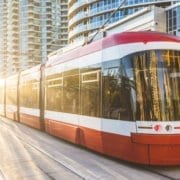Aligning Infrastructure Investment & CRE Development
It can be easy to forget how important infrastructure really is – it falls into the background and we just start to take it for granted without even realizing how much we truly depend on it on a daily basis. But having modern, reliable, safe, efficient infrastructure plays a critical role in the growth of the economy and is closely tied to the development of cities, as well as commercial real estate investment.
What is Infrastructure?
Infrastructure is defined as the basic physical and organizational structures, systems, and facilities needed for an economy to function. In general, infrastructure refers to transportation networks, communication networks, water and sanitation systems, and energy grids or power sources. As an article from Brookings suggests, “Infrastructure enables trade, powers businesses, connects workers to their jobs, creates opportunities for struggling communities, and protects the nation from an increasingly unpredictable natural environment. […] Infrastructure is the backbone of a healthy economy.”
To get an idea of the importance of infrastructure, the transportation network in America (including ports, air hubs, freight rail, and roads) moves $51 billion worth of goods each day.
But take into consideration the example of traffic congestion. While traffic can be an indicator of a thriving and vibrant urban area, it also clearly has some downsides. Traffic can mean people get to work late, resulting in lower productivity. It can mean goods take longer to move, and packages take longer to deliver, both of which ultimately raise costs for the end consumer. And it can mean more people decide to switch to public transportation, which decreases spending on automobiles and gas. Traffic congestion caused by poor infrastructure can have a snowball effect on the entire supply chain and even the economy.
Unfortunately, even in developed countries, infrastructure is often lacking, as it is expensive to build, maintain, and improve and funding is fragmented with regards to both source and prioritization. Infrastructure often requires a large up-front investment, is an extensive project, and can take years to see any sort of return. But infrastructure is necessary, as it drives faster economic growth and ensures that that growth is inclusive, i.e. accessible to a majority of the people in a specific area.
Where Do We Stand?
Every four years, the American Society of Civil Engineers produces a Report Card for America’s Infrastructure, reporting on the condition and performance of infrastructure in the United States. It takes into consideration key areas that include the following: aviation, bridges, dams, drinking water, energy, hazardous waste, inland waterways, levees, ports, public parks, rail, roads, schools, solid waste, transit, and wastewater. The most recent report in 2017 gave America’s infrastructure a D+ rating.
In another report, the World Economic Forum’s Global Competitiveness Index, the United States failed to rank as a top 10 country in terms of having efficient and reliable infrastructure, despite being one of the most developed countries in the world. And our still-growing population puts increasing strain on an already overtaxed infrastructure. The McKinsey Global Institute estimates that the US must spend a minimum of $150 billion per year on infrastructure to meet basic needs. And the American Society of Civil Engineers estimates that the country needs $3.6 trillion worth of upgrades by 2020 to get the infrastructure to a level that can be described as adequate.
How Does Infrastructure Tie to CRE?
According to Transwestern, “Cities have recognized that in order to stay competitive and generate economic development, the city’s infrastructure must keep up.” Any type of infrastructure upgrades and improvements has the near-certainty to boost rents, occupancy, and property value. JLL confirms that with their assertion, “Infrastructure is the most important factor influencing real estate investment and development decisions in cities around the world.”
Lack of adequate infrastructure can stall commercial property development by costing additional time, effort, and money to bring in resources to construction sites. The properties may also be less appealing to tenants if they are difficult to access. So it’s unsurprising that for the commercial real estate industry, the most useful infrastructure upgrades are related to transportation, which can decrease congestion and improve walkability. When infrastructure doesn’t scale at the same rate as commercial development, the economy will experience a bottleneck in growth, with byproducts that include increased traffic, slower communications connections, and higher consumer costs. However, good quality infrastructure drives economic productivity, connects supply chains, increases economic competitiveness, promotes production and the moving of goods, and more effectively meet the demands of the population. These findings beg the argument that there should be close alignment between land use planning and infrastructure planning. Further, current infrastructure and anticipated upgrades should be key considerations when making commercial real estate investments.











